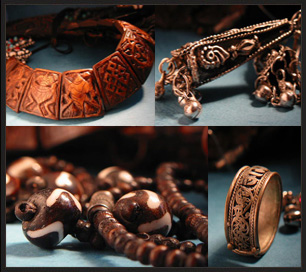|
Tibet Artwork, Tibetan Silver Jewelry , Tibetan Jewelry, Tibet Jewelry, Jewelry from Tibet, Tibetan Buddhist Jewelry, Tibetan Turquoise Jewelry, Tibetan Jewelery
Tibet Artwork, Tibetan Silver Jewelry , Tibetan Jewelry, Tibet Jewelry, Jewelry from Tibet, Tibetan Buddhist Jewelry, Tibetan Turquoise Jewelry, Tibetan Jewelery, Buddhist Jewelry
|
One of the most interesting examples is represented by the so-called black paintings. The special genre of the black thangkas, the potent, highly mystical paintings portraying shimmering, brilliant forms appearing out of a translucent darkness, came to full fruition in the second half of the 17th century.
Their aesthetic power derives from the contrast of powerful lines against a black background, making them one of the most effective means to appreciate the Tibetan mastery of line work. There is a range of variations in the technique, beyond the boldness of gold lines over a black background, to large figures and settings and a variety of colors, and orange, flamed halos.
Black paintings, a relatively late appearance in Buddhist art, have added yet another means by which artists can conjure up visions of mysterious transcendent worlds. Like the fierce deities who are often the subject matter of these thangkas, the blackness signifies the darkness of hate and ignorance as well as the role these qualities have to play in the awakening of clarity and truth.
Thangkas with black background form a special category of contemplative paintings. They are a highly mystical and esoteric type, usually reserved for advanced practice.
Black is the color of hate, transmuted by the alchemy of wisdom into compassion. Darkness represents the imminence of the absolute, the threshold of the experience. It is used for terrific ritual actions, the radical conquest of evil in all its forms - conquest not by annihilating, but by turning even evil into good. Thus, in the black paintings (Tibetan nagtang) the black ground casts forth deities in luminous visions of translucent colors.
|
Buddhist Symbols
In the earliest centuries of Buddhism, statues of the Buddha were not used. Instead, Buddhist art consisted of images symbolizing the Buddha and his teachings, such as the lotus, the Wheel of the Law, the Bodhi tree and the Buddha's footprints.
Eventually, the Buddha image became one of the most popular representations in Buddhism, but these early symbols remain important and are frequently used to this day. They are especially important in Theravada Buddhist countries like Sri Lanka and Thailand.
As Buddhism spread, Buddhist symbolism was enriched by the cultures it came into contact with. This is especially true of Buddhism in Tibet, which has developed a rich symbolic tradition. The central symbols of Tibetan Buddhism are the Eight Auspicious Symbols, known in Sanskrit as Ashtamangala (ashta meaning eight and mangala meaning auspicious). The Eight Auspicious Symbols are printed on Tibetan prayer flags, incorporated into mandalas and thangkas, and used in other forms of ritual art. Another important symbol is the Wheel of Life, a symbolic representation of the universe as understood by Tibetan Buddhists.
Other important types of symbolism in Buddhism include colors, especially the five colors of white, yellow, red, blue and green, and symbolic hand gestures called mudras. The articles in this section explore these Buddhist symbols, providing information on their history, meaning and use in Buddhism today. (For an introduction and quick guide to Buddhist colors, see our Chart of Buddhist Color Symbolism.)
|
|

Abhaya Mudra
|

Bhumisparsha Mudra
|
|
|
|
|
|
|
|
|
|
|

Lotus
|
|
|
|
|
|
|
|
|
|
|
|
|
|
|
|
|
|
|
--------------------------------------------------------------------------------------------------------
Labels: Tibetan artwork, tibet artwork, tibetan art, tibetan jewelry, handmade tibetan jewelry, tibetan bracelet, tibetan pendant, tibetan necklace, gau box pendant, tibetan ornament, tibetan statue, tibetan thangkas, tibetan singing bowl, buddhist jewelry, buddhist art
|
|




添加新评论